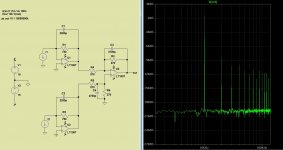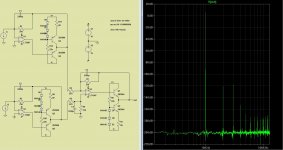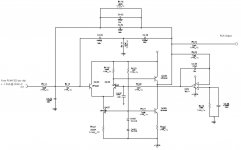The I/V converter in pcm1794a datasheet is one good example of how you should not use op amp´s, and is because circuits like this that op amp´s have such a bad reputation.
Op amps normally have low quiescent current, and should use large load impedances if one want that they stay in "class a" operation (low distortion).
The circuit in pcm1794a datasheet use very low output impedances in the load of op amp´s and because of that, they work in "class b" (high distortion).
This circuit has 0.003% distortion at 10Khz
Op amps normally have low quiescent current, and should use large load impedances if one want that they stay in "class a" operation (low distortion).
The circuit in pcm1794a datasheet use very low output impedances in the load of op amp´s and because of that, they work in "class b" (high distortion).
This circuit has 0.003% distortion at 10Khz
Attachments
Last edited:
One way to remedy this is using a buffer at each op amp.
below is the same circuit but with the addition of 3 buffers, now each op amp sees a much higher load impedance and the buffers work in class a.
The distortion is much lower. Now we have a distortion of only 0.00007% at 10Khz, consisting only of 2º and 3º harmonics, the distortion is even lower at 1Khz (0.000005%).
This is a big improvement over the original circuit.
This simple buffers have been shown to me by Xslavic at post 20 of
http://www.diyaudio.com/forums/digital-source/217459-dac-i-v-convertion-very-low-distortion.html
below is the same circuit but with the addition of 3 buffers, now each op amp sees a much higher load impedance and the buffers work in class a.
The distortion is much lower. Now we have a distortion of only 0.00007% at 10Khz, consisting only of 2º and 3º harmonics, the distortion is even lower at 1Khz (0.000005%).
This is a big improvement over the original circuit.
This simple buffers have been shown to me by Xslavic at post 20 of
http://www.diyaudio.com/forums/digital-source/217459-dac-i-v-convertion-very-low-distortion.html
Attachments
I concur. It seems they recommend such low resistances to minimize Johnson noise. Such noise is likely the limiting factor in approaching 24-bit static resolution from the converter. Personally, I'd choose higher noise over higher distortion.
I think that with the buffers we can have both low distortion and low noise.
what you guys think? and what is your experience.
I learned something. thanks. Is the noise the stuff @ -200dB in your FFT for this circuit?
I suppose an IC buffer would be OK also?
No Dirk, unfortunately the noise floor will be higher. LTspice don´t simulate noise in transient analysis. You need to run a Noise simulation for that, so just ignore this -200db
the U1 op amp has a 21ma pp swing, so even a ic buffer may enter class b, and is more expensive.
I think that with the buffers we can have both low distortion and low noise.
what you guys think? and what is your experience.
This is an interesting topic. From a overall systems perspective, and from my own emprical experience, I've come to conclude that Johnson noise is not much of a listening enjoyment impediment for any hifi system with audiophile pretensions. Consider vinyl LP. Many LPs have only 70dB to 80dB of SNR, yet few audiophiles seem to find that this significantly interferes with their listening enjoyment.
I feel that the Johnson noise (not the quantization noise, or dither noise) of a digital audio system, what with it's potential for well over 90dB SNR, is even less of an listening impediment. Truly random noise seems to recede from our concious awareness, so long as more important subjective factors are are being properly handled. For example, I don't feel that quantized resolution is anywhere near the most pressing problem for digital audio sound quality which the faults of the CD medium have led people to conclude. I feel that the main subjective problems of digital audio are time-domain related.
Those low value resistors in the datasheet application examples can make a difference in a laboratory measurement of static resolution for what is marketed as a 24-bit converter. However, for the reproduction of dynamic A.C. signals such as music, which were recorded in a natural ambient noise floor environment, and using microphones and other fromt-end electronics, taking pains to objectively approach 24-bit noise levels might be counter-productive to more important subjective factors.
Last edited:
This is an interesting topic. From a overall systems perspective, and from my own emprical experience, I've come to conclude that Johnson noise is not much of a listening enjoyment impediment for any hifi system with audiophile pretensions. Consider vinyl LP. Many LPs have only 70dB to 80dB of SNR, yet few audiophiles seem to find that this significantly interferes with their listening enjoyment.
I feel that the Johnson noise (not the quantization noise, or dither noise) of a digital audio system, what with it's potential for well over 90dB SNR, is even less of an listening impediment. Truly random noise seems to recede from our concious awareness as long as more important subjective factors are are being properly handled. I don't feel that quantized resolution is anywhere near the most pressing problem for digital audio sound quality. I feel it's main subjective problems are time-domain related.
Well, I suffer from tinnitus so I know all about ignoring noise.
No Dirk, unfortunately the noise floor will be higher. LTspice don´t simulate noise in transient analysis. You need to run a Noise simulation for that, so just ignore this -200db
the U1 op amp has a 21ma pp swing, so even a ic buffer may enter class b, and is more expensive.
How about a trio of LME49600?
There's always a bigger hammer.
Cost shouldn't be a consideration in my opinion because a power supply and a nice box will be far more expensive than a few chips.
Last edited:
How about a trio of LME49600?
There's always a bigger hammer.
Cost shouldn't be a consideration in my opinion because a power supply and a nice box will be far more expensive than a few chips.
Three op-amps in parallel could reduce Johnson noise, but by no more than 9.5dB relative to a single such op-amp. However, you would need to isolate the low impedance output of each op-amp from that of the others with a resistor, so not the have them buck each other, which would increase distortion. Not what we want. Output isolation resistors will contribute their own Johnson noise, reducing that theoretical 9.5dB figure.
Three op-amps in parallel could reduce Johnson noise, but by no more than 9.5dB relative to a single such op-amp. However, you would need to isolate the low impedance output of each op-amp from that of the others with a resistor, so not the have them buck each other, which would increase distortion. Not what we want. Output isolation resistors will contribute their own Johnson noise, reducing that theoretical 9.5dB figure.
I was only half serious Ken. I also meant using one LME49600 in place of each of the buffers for three total in the entire circuit. I should try different emoticons to convey my silliness. This is supposed to be fun after all.
I'm surprised that the SK170 in source follower mode wasn't used for the buffer... everyone's favorite transistor! (I got an idea - an entire hifi made with nothing but SK170's!
Thanks for sharing your opinion about noise ken. but Unfortunately professional audio is a specs war , and wins the lowest noise. that's the reason the original circuit is so bad, with low resistors they have the low noise specs, and at 1khz the distortion seems tolerable . This is what the average consumer wants.
I was only half serious Ken. I also meant using one LME49600 in place of each of the buffers for three total in the entire circuit. I should try different emoticons to convey my silliness. This is supposed to be fun after all.
I'm surprised that the SK170 in source follower mode wasn't used for the buffer... everyone's favorite transistor! (I got an idea - an entire hifi made with nothing but SK170's!)
My mistake, dirk. I'm sometimes slow on the uptake.
On top of which my 9.5dB figure was wrong anyhow. The figure should have been around 4.7dB.
Last edited:
This is an interesting topic
unfortunately not everybody thinks like you, i was hoping that more people would share their experience in using op amps and buffers.
unfortunately not everybody thinks like you, i was hoping that more people would share their experience in using op amps and buffers.
I don't have much of any experience so I have nothing to share, sorry.
Not too long ago I started a topic on looking how to improve the PCM1794 I/V stage as well. It was looking into the op-amp implementation of the circuit by using different ICs.
http://www.diyaudio.com/forums/digi...mulation-pcm1794-some-help-wisdom-needed.html
IC selection plays a big role as well in the circuit. I was focusing more on optimal IC selection at the I/V buffer stage because that's seems to be the weakest link to me.
I do lack the decades of experience of most on this forum but just by reading a bit on Johnson Noise (thermal noise of components?) it seems that it is relatively low and the IC and it's complementing component selection is key to great results.
Currently I have stopped my simulations (and DAC design) due to school and work but I plan continuing in the near future and coming up witth two new IC selections for the pcm1794 IV stage and a modifyable IV opamp stage so we can all experiment. Hope I can get to it sooner :/
http://www.diyaudio.com/forums/digi...mulation-pcm1794-some-help-wisdom-needed.html
IC selection plays a big role as well in the circuit. I was focusing more on optimal IC selection at the I/V buffer stage because that's seems to be the weakest link to me.
I do lack the decades of experience of most on this forum but just by reading a bit on Johnson Noise (thermal noise of components?) it seems that it is relatively low and the IC and it's complementing component selection is key to great results.
Currently I have stopped my simulations (and DAC design) due to school and work but I plan continuing in the near future and coming up witth two new IC selections for the pcm1794 IV stage and a modifyable IV opamp stage so we can all experiment. Hope I can get to it sooner :/
smms73, seeing your so handy at running sim's, could you do me a favour and run the sim on this, circuit.
As so far it has sounded so much better than anything I have ever heard, esspecially in dynamics from top to bottom, but what I have noticed is that it is very unkind to bad recordings, but if the recording is good it is very sweet sounding even with the massive dynamics it has.
As so far it has sounded so much better than anything I have ever heard, esspecially in dynamics from top to bottom, but what I have noticed is that it is very unkind to bad recordings, but if the recording is good it is very sweet sounding even with the massive dynamics it has.
Attachments
- Status
- This old topic is closed. If you want to reopen this topic, contact a moderator using the "Report Post" button.
- Home
- Source & Line
- Digital Source
- The pcm1794a datasheet I/V converter and how to improve it.


